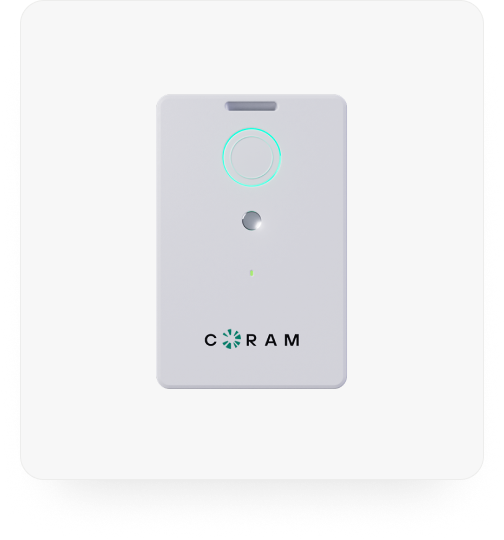If something goes wrong at work, how fast can your team call for help?
Most businesses still rely on smartphones, radios, or shouting, all of which are unreliable when seconds count. A wearable panic button for employees changes that. It's fast, discreet, and doesn’t depend on signal strength or unlocked phones. It’s peace of mind in a compact form.
In this article, you’ll learn:
- How wearable panic buttons work and why apps don’t cut it
- The real-world benefits for high-risk or isolated roles
- Where they fit best across offices, schools, hotels, clinics, and more
How Wearable Panic Buttons Work?
A wearable panic button for employees is built for one job: helping someone get assistance when they feel unsafe or need help quickly, quietly, and without delay. These devices are small enough to wear around the neck, clip to a belt, or attach to an ID badge, but what matters is what happens when they’re pressed.
Here’s what goes on behind the scenes:
Press-to-alert functionality
The employee presses the button, usually holding it for one or two seconds to avoid false triggers. This sends a silent alert. In high-risk roles, silence matters more than sirens. The person in trouble shouldn’t have to unlock a phone, open an app, or wait on hold.
Some devices include fall detection or no-motion alerts, which can trigger automatically if an employee is unresponsive or suffers a sudden impact. This is useful in roles where physical accidents are a concern, such as maintenance, security, or healthcare.
Signal transmission and location tracking
The wearable panic button connects to a nearby gateway or hub through:
- Bluetooth, for short-range signals when paired with a mobile device
- Wi-Fi, common in indoor environments like offices or hotels
- Cellular or GPS, for workers in the field or moving between locations
In larger facilities, some systems use indoor positioning technology or BLE beacons to pinpoint the employee’s exact location, even on a specific floor or room. This removes the guesswork from response and ensures help goes exactly where it's needed.
Alert escalation and notifications
Once triggered, the system sends the alert to a pre-configured list. This might include:
- On-site security teams
- Shift supervisors
- A centralized monitoring center
- Emergency dispatchers
The alert typically includes:
- The employee’s name and ID
- Their real-time location
- The type of alert (e.g., red for emergency, yellow for suspicious behavior, green for check-in)
Some systems offer multi-channel delivery: text, call, app push, or even automated workflows into platforms like Slack or MS Teams, depending on integrations.
No more surprises or delays. A wearable panic button doesn’t wait for someone to notice a problem. It sends the right data to the right people so your team can act, not just react.
Why Coram’s Panic Button is the Best for Employees

Coram builds its wearable panic button system with one goal in mind: to make it easy for employees to get help and make it fast for teams to respond. No apps, delays, or any sort of guesswork.
When evaluating safety technology, the question isn't whether you need a wearable panic button for employees; it's whether the one you choose works when it matters.
This system’s panic button stands out because it does three things right: it activates instantly, delivers accurate location data, and fits into your operations without friction.
Let’s break it down.
1. Built for real emergencies
Coram’s panic button is designed for high-pressure moments. One press triggers a silent alert; you don’t have to open an app or do guesswork at the last moment. The system supports multiple alert levels (like red for emergencies or yellow for suspicious behavior), so teams can respond based on context.
Depending on how your organization is structured, you can configure it to:
- Notify on-site security directly
- Alert off-site responders or supervisors
- Trigger lockdown protocols or broadcast facility-wide alerts
The signal is transmitted over secure, real-time networks, with indoor location tracking accurate enough to pinpoint a floor, room, or zone, even where GPS fails.
2. Simple for employees, seamless for admins
Every extra step adds friction. Coram removes it. Employees don’t need phones or training manuals. The device works with a press, and that's it.
From an admin side, the platform offers:
- A clean dashboard to assign, manage, and monitor devices
- Integration with other systems, like access control or communications platforms
- Centralized logging for incident reviews or compliance reporting
You know where every device is. You know who has it. And you get alerts in real time, with no blind spots.
3. Adapts to your environment
Whether you're rolling this out across one office or ten sites, Coram’s system scales. You can:
- Set location-specific escalation paths
- Customize features by role or department
- Add geofencing for restricted or high-risk zones
This feature is built to reflect how you run safety across departments, shifts, or locations, without requiring a full rip-and-replace of existing systems.
4. Reinforces a safety-first culture
Deploying panic buttons is not a compliance move but a visible signal to your workforce that you’re serious about their safety, especially for lone workers, night shifts, or teams in high-contact roles.
And that shift is measurable. Companies that implement wearable alert systems like Coram often report:
- Increased incident reporting (because the system is easy to use)
- Shorter emergency response times
- Higher retention in frontline roles where safety anxiety is common
There are no sort of bloated features or unnecessary complexity. Just a reliable way to keep your people safe, and your response team informed.
Benefits of Wearable Panic Buttons for Employees
A wearable panic button for employees gives your team a simple, fast way to call for help when something goes wrong. It improves response times, reduces risk, and builds a safer work environment, especially for roles where employees work alone or face the public.
Here’s what the right panic button system delivers:
Faster Emergency Response
When something goes wrong, time gets tight. A wearable panic button eliminates delays by turning a single press into a direct signal to the right responders. No need to unlock a phone, open an app, or call a number.
This is especially important in:
- Medical incidents where every second matters
- Physical altercations, where vocal alerts may escalate the threat
- Large or multi-level building,s where locating someone manually wastes critical time
With some surveillance systems, alerts can include real-time location data, letting security or medical staff respond with precision.
The result? Faster decisions, faster support, and fewer blind spots.
Increased Employee Confidence and Morale
It’s hard to focus on your work when safety feels uncertain. Panic buttons act as a safety net, and people work better when they know it’s there.
Employees don’t want to wonder:
- “Will anyone hear me if something happens?”
- “Will I be blamed if I speak up about a threat?”
By making it easy to call for help without drawing attention, wearable panic buttons remove that hesitation. This leads to:
- Better focus, especially in high-contact or customer-facing roles
- Lower stress levels in late shifts or isolated workspaces
- Stronger trust in management’s commitment to safety
And over time, those effects compound the lowering turnover, improving engagement, and reinforcing a workplace culture where people feel protected, not disposable.
Protection in Isolated or High-Risk Roles
Some roles carry more risk by design. That doesn’t mean your people should face it alone.
Panic buttons are especially valuable for:
- Lone workers (technicians, field agents, maintenance staff)
- Night shift staff with limited backup
- Housekeeping or healthcare workers with direct exposure to unpredictable situations
- Front desk staff who often serve as the first point of contact
In these environments, help isn’t always nearby. A wearable panic button becomes the bridge between isolation and action, silently triggering alerts that connect employees to responders in seconds.
And unlike phone-based systems, wearable buttons don’t rely on mobile apps staying open, Wi-Fi staying connected, or users being able to speak.
Bottom line: The real benefit of a wearable panic button isn't just faster alerts. It's the confidence your teams gain knowing that if something happens, they don’t have to face it alone, and your organization won’t respond too late.
Use Cases Across Industries
A wearable panic button for employees is not a one-industry tool.
It solves a universal problem: how to get help when you're vulnerable and alone. From hospitals to hotels to field teams in remote areas, the use cases are grounded in real safety risks that organizations face every day.
Here’s how different industries are putting it to work.
1. Healthcare (Nurses, Doctors, Emergency Staff)
Healthcare workers are often in high-stress, unpredictable environments. Whether they’re on-call, working late shifts, or handling volatile patients, the need for instant, silent alerts is real.
Use cases:
- ER nurses and on-site physicians who face verbal or physical aggression from patients or visitors
- Home healthcare staff entering unfamiliar neighborhoods or homes alone
- Behavioral health professionals dealing with high-risk patients, where de-escalation can turn quickly
Coram’s system helps teams respond without delay, while also maintaining discretion, a key need in patient-facing roles.
2. Education (Teachers, School Staff)
In schools, especially large campuses or under-resourced districts, help isn't always nearby. Panic buttons offer a way for staff to escalate quickly without relying on phones or public intercoms.
Use cases:
- Teachers in isolated classrooms or outdoor areas need support during behavioral incidents or intruder threats
- Counselors and nurses working one-on-one with students
- School bus drivers, especially those on long or rural routes, may face medical issues, vehicle problems, or student safety concerns
One press connects them to school security or administrators, with location data to remove guesswork.
3. Hospitality (Hotel Staff, Housekeeping)
Hotels present unique challenges: staff working alone, behind closed doors, often without line of sight to help. Wearable panic buttons are no longer optional in many cities; they’re now part of safety legislation.
Use cases:
- Housekeepers cleaning occupied rooms, sometimes encountering harassment or threatening guests
- Maintenance crew operating in mechanical rooms or stairwells
- Security officers doing rounds in large properties with multiple blind spots
Panic buttons give staff immediate support and deter potential aggressors who know the system is in place.
4. Corporate and Office Environments
Office safety is not only about fire drills. Employees who work late or alone, especially in large buildings or secure areas, often lack direct access to help.
Use cases:
- IT or maintenance teams working after hours or in server rooms
- Front-desk staff who handle visitor check-ins and can be the first point of conflict
- Employees on extended shifts, especially during off-peak hours with reduced security presence
Wearable panic buttons provide a quiet, fast link to on-site security, without needing a phone or making a scene.
5. Field Workers and Lone Workers
For teams out in the field, help is rarely one door away. Whether they’re fixing infrastructure, collecting samples, or making deliveries in unknown areas, fast response tools are a matter of risk management.
Use cases:
- Construction workers at height or operating alone on remote job sites
- Delivery drivers working odd hours or entering gated areas where phone signals can drop
- Utility technicians servicing power lines, gas systems, or water facilities
- Environmental field staff who may work hours from the nearest help
With an apt surveillance system solution, a press of the button can send location data even in areas where GPS underperforms, thanks to hybrid tracking setups and integration with site-specific systems.
Each of these industries faces different threats, but they share the same need: immediate, reliable access to help. That’s what Coram’s wearable panic button delivers.
Protecting Your Team Starts With One Press
A wearable panic button for employees helps teams respond faster, stay safer, and work with confidence, especially when they're alone, at risk, or out of sight.
- Cut response times with one-press alerts that silently notify the right people, with real-time location included.
- Support high-risk roles by giving employees an easy, discreet way to request help.
- Avoid app failures with reliable devices that work without phones or strong signals.
- Set it up anywhere from hospitals to hotels, offices to field teams.
Coram’s panic button system makes that level of safety possible, simple to use, quick to deploy, and ready for real-world situations.
Sounds like something you are looking for? Book a demo now.
FAQ
A wearable panic button for employees offers faster, easier access to help in high-pressure situations. Unlike mobile apps, it doesn’t rely on a phone, screen taps, or a strong signal.
Here’s the key difference:
- One-step activation: Just press the button; you don’t have to unlock, swipe, or wait.
- Always accessible: Worn on the body, it stays within reach even if the employee is injured or restrained.
- More discreet: Silent alerts don’t draw attention, which reduces the risk of escalating a threat.
- More reliable: Some devices connect through local networks or gateways, making them usable even in areas with poor cell service.
Apps are useful for check-ins and non-urgent reporting. But in real emergencies, wearables are built for speed and simplicity.
Yes. A wearable panic button for employees can be just as effective for a 10-person team as it is for a large enterprise. In fact, smaller businesses often benefit even more because they typically have fewer layers of support on-site.
Here’s why they make sense:
- Low barrier to entry: Most systems are affordable, easy to set up, and don’t require heavy IT involvement.
- Scales with your team: You can start with just a few devices and expand as your needs grow.
- Boosts employee trust: Giving staff a quick way to signal for help shows you take their safety seriously.
- Works in lean operations: Whether it’s a retail shop, office, or remote crew, help is just one press away.
It’s a simple safety upgrade that fits into small business budgets and workflows.
Once an employee presses the wearable panic button, the system immediately sends a silent alert to the assigned responders; neither you nor they will hear random noise, nor will you have to deal with random attention drawn.
Here’s what happens next:
- Real-time location is shared so responders know exactly where to go
- Security or emergency teams are notified via text, dashboard, or integrated systems
- Escalation protocols kick in if no one responds, triggering backup alerts or lockdowns
- Some systems support two-way communication to assess the situation without delay
Everything is designed to minimize response time and maximize clarity, without requiring the employee to say a word.





%20(6).webp)








.webp)
